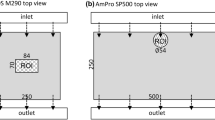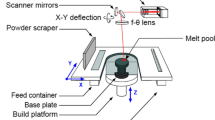Abstract
In laser powder-bed fusion (LPBF), the actual thickness of powder particles that spread on solidified zones, so-called effective layer thickness (ELT), is higher than the nominal layer thickness. The source cause of this discrepancy is the fact that powder particles substantially shrink after selective melting, followed by solidification. ELT, as an unknown parameter, depends on process parameters and material properties. In this study, an effective method to measure ELT is proposed and applied to 17-4 PH stainless steel for a nominal build layer thickness of 20 µm. The measured ELT was larger than 100 µm, which is far beyond the values reported in the literature. Results obtained from the current study show the effect of applying the ELT rather than the nominal build layer thickness in numerical modeling studies as well as understanding the governing physics in the LPBF process.








Similar content being viewed by others
References
Fayazfar H et al (2018) A critical review of powder-based additive manufacturing of ferrous alloys: process parameters, microstructure and mechanical properties. Mater Des 144:98–128
Ma M, Wang Z, Gao M, Zeng X (2015) Layer thickness dependence of performance in high-power selective laser melting of 1Cr18Ni9Ti stainless steel. J Mater Process Technol 215(1):142–150
Spierings AB, Herres N, Levy G (2011) Influence of the particle size distribution on surface quality and mechanical properties in AM steel parts. Rapid Prototyp J 17(3):195–202
Tan JH, Wong WLE, Dalgarno KW (2017) An overview of powder granulometry on feedstock and part performance in the selective laser melting process. Addit Manuf 18:228–255
Spierings AB, Levy G (2009) Comparison of density of stainless steel 316L parts produced with selective laser melting using different powder grades. In: Solid Free. Fabr. Proc., pp 342–353
Meier H, Haberland C (2008) Experimental studies on selective laser melting of metallic parts. Materwiss Werksttech 39(9):665–670
Zhang DQ, Cai QZ, Liu JH, Li RD (2010) A powder shrinkage model for describing real layer thickness during selective laser melting process. Adv Mater Res 97–101:3820–3823
Gürtler Fj, Karg M, Dobler M, Kohl S, Tzivilsky3 I, Schmidt M (2014) Influence of powder distribution on process stability in laser beam melting: Analysis of melt pool dynamics by numerical simulations. In: Solid free. symp. Texas, pp 1099–1117
Mindt HW, Megahed M, Lavery NP, Holmes MA, Brown SGR (2016) Powder bed layer characteristics: the overseen first-order process input. Metall Mater Trans A Phys Metall Mater Sci 47(8):3811–3822
Ali U et al (2018) On the measurement of relative On the measurement of relative powder-bed compaction density in powder-bed additive manufacturing processes. J Mater Des 155:495–501
Jacob G, Donmez A, Slotwinski J, Moylan S (2016) Measurement of powder bed density in powder bed fusion additive manufacturing processes. Meas Sci Technol 27(11):115601
Egger G, Gygax PE, Glardon R, Karapatis NP (1999) Optimization of powder layer density in selective laser sintering. In: 10th Solid Free. Fabr. Symp., pp 255–263
Choi J-P et al (2017) Evaluation of powder layer density for the selective laser melting (SLM) process. Mater Trans 58(2):294–297
Kundakcıoğlu E, Lazoglu I, Poyraz Ö, Yasa E, Cizicioğlu N (2018) Thermal and molten pool model in selective laser melting process of Inconel 625. Int J Adv Manuf Technol 95:3977–3984
Martinson P, Daneshpour S, Koçak M, Riekehr S, Staron P (2009) Residual stress analysis of laser spot welding of steel sheets. Mater Des 30(9):3351–3359
Sabau AS, Porter WD (2008) Alloy shrinkage factors for the investment casting of 17-4PH stainless steel parts. Metall Mater Trans B Process Metall Mater Process Sci 39(2):317–330
Acknowledgements
This work was supported by funding from the Natural Sciences and Engineering Research Council of Canada (NSERC) and the Federal Economic Development Agency for Southern Ontario (FedDev Ontario). The authors would also like to acknowledge the help from Jerry Ratthapakdee and Karl Rautenberg for helping with design and printing the LPBF parts.
Author information
Authors and Affiliations
Corresponding author
Additional information
Publisher’s Note
Springer Nature remains neutral with regard to jurisdictional claims in published maps and institutional affiliations.
Rights and permissions
About this article
Cite this article
Mahmoodkhani, Y., Ali, U., Imani Shahabad, S. et al. On the measurement of effective powder layer thickness in laser powder-bed fusion additive manufacturing of metals. Prog Addit Manuf 4, 109–116 (2019). https://doi.org/10.1007/s40964-018-0064-0
Received:
Accepted:
Published:
Issue Date:
DOI: https://doi.org/10.1007/s40964-018-0064-0




